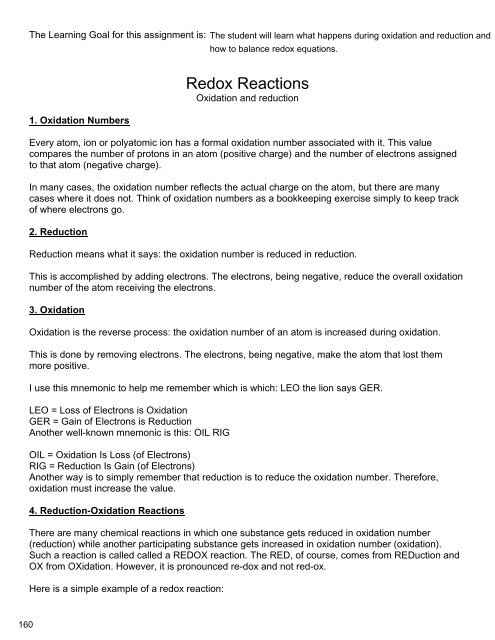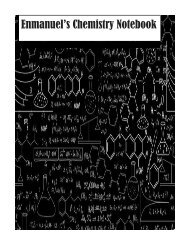You also want an ePaper? Increase the reach of your titles
YUMPU automatically turns print PDFs into web optimized ePapers that Google loves.
The Learning Goal for this assignment is:<br />
1. Oxidation Numbers<br />
Redox Reactions<br />
Oxidation and reduction<br />
Every atom, ion or polyatomic ion has a formal oxidation number associated with it. This value<br />
compares the number of protons in an atom (positive charge) and the number of electrons assigned<br />
to that atom (negative charge).<br />
In many cases, the oxidation number reflects the actual charge on the atom, but there are many<br />
cases where it does not. Think of oxidation numbers as a bookkeeping exercise simply to keep track<br />
of where electrons go.<br />
2. Reduction<br />
Reduction means what it says: the oxidation number is reduced in reduction.<br />
This is accomplished by adding electrons. The electrons, being negative, reduce the overall oxidation<br />
number of the atom receiving the electrons.<br />
3. Oxidation<br />
Oxidation is the reverse process: the oxidation number of an atom is increased during oxidation.<br />
This is done by removing electrons. The electrons, being negative, make the atom that lost them<br />
more positive.<br />
I use this mnemonic to help me remember which is which: LEO the lion says GER.<br />
LEO = Loss of Electrons is Oxidation<br />
GER = Gain of Electrons is Reduction<br />
Another well-known mnemonic is this: OIL RIG<br />
OIL = Oxidation Is Loss (of Electrons)<br />
RIG = Reduction Is Gain (of Electrons)<br />
Another way is to simply remember that reduction is to reduce the oxidation number. Therefore,<br />
oxidation must increase the value.<br />
4. Reduction-Oxidation Reactions<br />
There are many chemical reactions in which one substance gets reduced in oxidation number<br />
(reduction) while another participating substance gets increased in oxidation number (oxidation).<br />
Such a reaction is called called a REDOX reaction. The RED, of course, comes from REDuction and<br />
OX from OXidation. However, it is pronounced re-dox and not red-ox.<br />
Here is a simple example of a redox reaction:




